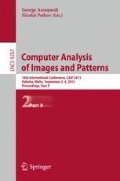Abstract
When devices and applications provide assistance to people they become part of assistive technology. If the assistance is given to impaired people, then it is possible to refer those technologies as adaptive technologies. The main aims of these systems are substitution of physical assistants and the improvement of typical tools already available for impaired people. In this paper some benefits and examples of adaptive technology applications will be discussed. Moreover we present an adaptive technology framework to avoid obstacles to be exploited by visually impaired and blind people. The proposed assistive technology has been designed to perform vision substitution; specifically it provides Electronic Travel Aid (ETA) capabilities through the processing of information acquired with a depth sensor such that the user can avoid obstacles during the environment exploration. In the proposed system we require to know just the height of the sensor with respect to the ground floor to calibrate the ETA system. Experiments are performed to asses the proposed system.
Access this chapter
Tax calculation will be finalised at checkout
Purchases are for personal use only
Preview
Unable to display preview. Download preview PDF.
References
Stanco, F., Buffa, M., Farinella, G.M.: Automatic Braille to Black Conversion. In: Baldoni, M., Baroglio, C., Boella, G., Micalizio, R. (eds.) AI*IA 2013. LNCS, vol. 8249, pp. 517–526. Springer, Heidelberg (2013)
Website of OrCam wearable adaptive technology device for visually impaired people. (last visited on April 1, 2015). http://www.orcam.com/
Kanade, T.: Quality of life technology [scanning the issue]. Proceedings of the IEEE 100(8), 2394–2396 (2012)
Website of the World Health Organization. (Updated august 2014, last visited on June 11, 2015). http://www.who.int/mediacentre/factsheets/fs282/en/
Dakopoulos, D., Bourbakis, N.G.: Wearable obstacle avoidance electronic travel aids for blind: A survey. IEEE Transaction on Systems, Man, and Cybernetics-Part C: Applications and Reviews 40(1) (January 2010)
Italian website of International Agency for the Prevention of Blindness (Published April 2009, last updated August 2014, last visited on June 11, 2015). http://www.iapb.it/news2.php?ozim=54
Terven, J.R., Salas, J., Raducanu, B.: New opportunities for computer vision-based assistive technology systems for the visually impaired. Computer 47(4), 52–58 (2014)
Meijer, P.B.L.: An experimental system for auditory image representations. IEEE Transactions on Biomedical Engineering 39 (February 1992)
Aguerrevere, D., Choudhury, M., Barreto, A.: Portable 3d sound / sonar navigation system for blind individuals. In: Second LACCEI International Latin American and Caribbean Conference for Engineering and Technology (June 2004)
Spanish website of Espacio Acstico Virtual (Virtual Acoustic Space) (last visited on April 1, 2015). http://www.iac.es/proyecto/eavi/
Vera, P., Zenteno, D., Salas, J.: A smartphone-based virtual white cane. Pattern Analysis and Applications 17 (August 2014)
Aggarwal, A., Kukreja, A., Chopra, P.: Vision based collision avoidance by plotting a virtual obstacle on depth map. In: IEEE International Conference on Information and Automation (ICIA), pp. 532–536 (2010)
Boyu, W., Junyao, G., Li, K., Fan, Y., Xueshan, G., Gao, B.: Indoor mobile robot obstacle detection based on linear structured light vision system. In: IEEE International Conference on Robotics and Biomimetics, pp. 834–839 (2009)
Yue, H., Chen, W., Wu, X., Zhang, J.: Kinect based real time obstacle detection for legged robots in complex environments. In: 8th IEEE Conference onIndustrial Electronics and Applications (ICIEA), pp. 205–210 (2013)
Website of Microsoft Kinect (Components and Specifications). (last visited on April 1, 2015). http://msdn.microsoft.com/en-us/library/jj131033.aspx
Bi, J., Bennett, K.P.: Regression error characteristic curves. In: International Conference on Machine Learning, pp. 43–50 (2003)
Author information
Authors and Affiliations
Corresponding author
Editor information
Editors and Affiliations
Rights and permissions
Copyright information
© 2015 Springer International Publishing Switzerland
About this paper
Cite this paper
Milotta, F.L.M., Allegra, D., Stanco, F., Farinella, G.M. (2015). An Electronic Travel Aid to Assist Blind and Visually Impaired People to Avoid Obstacles. In: Azzopardi, G., Petkov, N. (eds) Computer Analysis of Images and Patterns. CAIP 2015. Lecture Notes in Computer Science(), vol 9257. Springer, Cham. https://doi.org/10.1007/978-3-319-23117-4_52
Download citation
DOI: https://doi.org/10.1007/978-3-319-23117-4_52
Published:
Publisher Name: Springer, Cham
Print ISBN: 978-3-319-23116-7
Online ISBN: 978-3-319-23117-4
eBook Packages: Computer ScienceComputer Science (R0)

